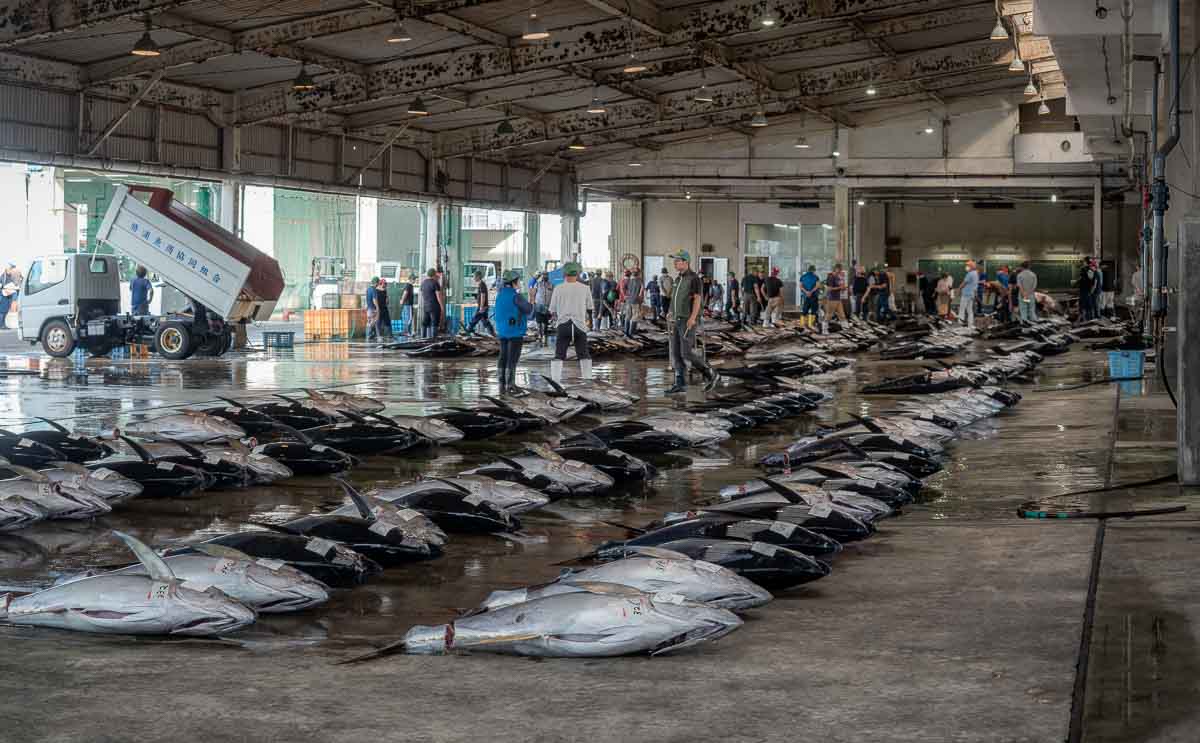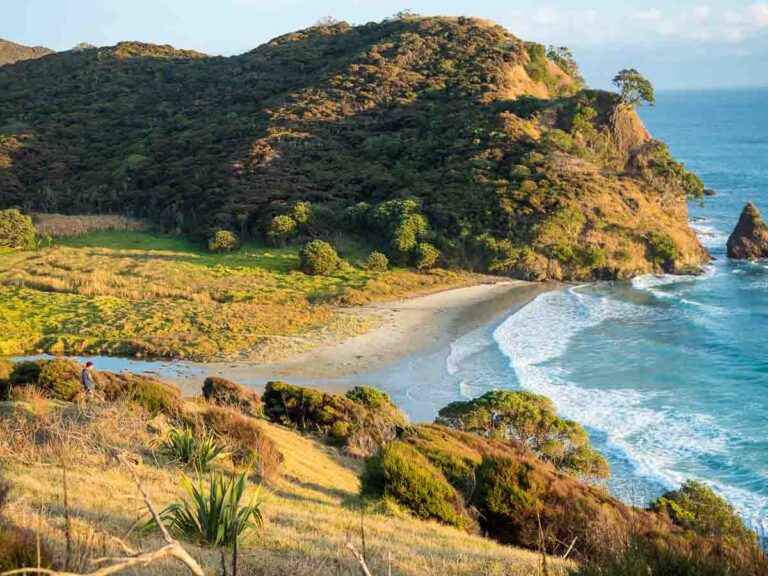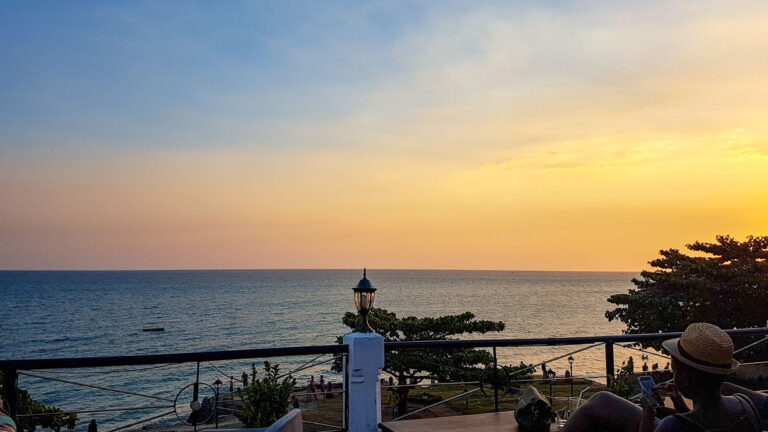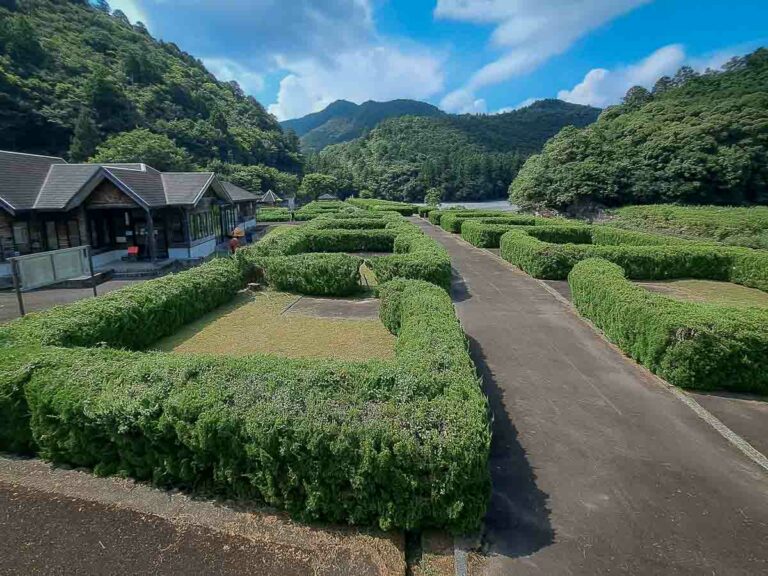Nachi Katsuura Tuna Market (Why You Should Visit!)
After completing the Kumano Kodo hike, we made our way out of the forest and down to the peaceful seaside town of Nachi Katsuura (Also known as Kii-Katsuura).
Katsuura is famous for its Tuna Market – The biggest outside of Tokyo.
(And what’s better, you don’t need to get up at 5am to go see the theatrics!)
The action begins at 7 am and has a more intimate feel than its more famous counterpart in Tokyo. And if you explore it with a tour guide, you’ll get to sample the freshest tuna you’ll ever get your hands on – but you can also just rock up by yourself and peer in through the mesh screens.
In this post, I’ll shed some light on how to get to your destination and what to expect when you reach the observation decks.
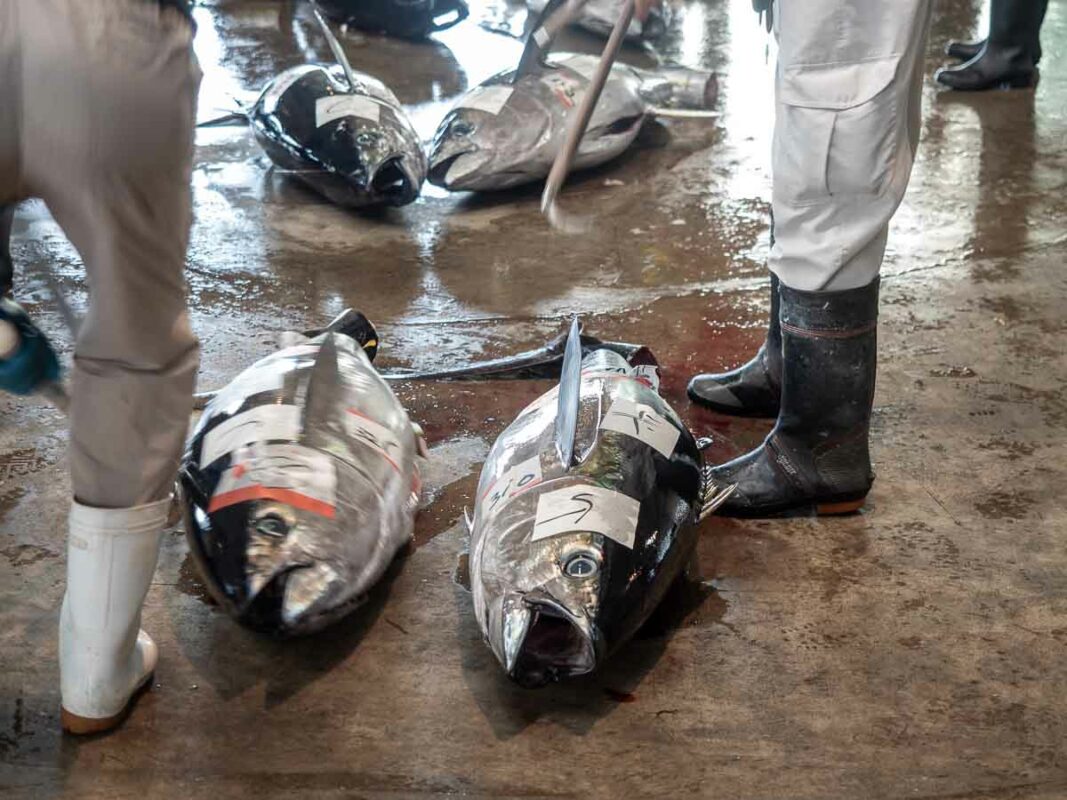
Table of Contents
The Largest Tuna Market Outside Of Tokyo
Kii-Katsuura fish market holds the title of the biggest tuna market in Japan outside of Tokyo.
And for good reason.
Its coasts boasts some of the best tuna fishing grounds in the country, with massive bluefin tuna weighing hundreds of pounds. While tuna is the main specialty, you’ll also spot other catches like sharks, swordfish, and more.
The tuna is strictly controlled, ensuring only the highest quality. It must meet specific age and weight criteria, and net fishing is prohibited. They’re focused on mature tuna caught using line-fishing methods to ensure healthy fish stocks for the future.

Kii-Katsuura Tuna Market vs. The Tokyo Tuna Market
Tokyo’s market, Toyosu, is larger and retains its status as the biggest fish market in the world. For this reason, it draws in a crowd. It’s vibrant and boasts a large selection of fish.
On the other hand, Kii-Katsuura offers a more intimate and authentic experience. Though it’s popular with tourists and locals alike, you don’t necessarily have to arrive early to witness the auction. It has a local feel and offers the opportunity to witness the auction without the overwhelming crowds of Toyosu.
I was anticipating some intense bidding. Something similar to the bustle I experienced at the Toyosu Market. Instead, I witnessed a subdued activity. Given the town itself is laid back, this kinda made sense.
How to Get There
From Osaka, you’ll take a train to Kii-Katsuura. The market is just a short walk (about five minutes) from Kii-Katsuura Station.
You’ll want to get to the market early(ish), around 7am.

This is a whole lot more friendly than the Tokyo market which kicks off around 4.30am!
But still, it’s a long train ride from Osaka so you’ll probably need to stay in or around Nachi Katsuura the night before if you want to attend the market.
Opening Hours
The market itself is generally open from sunrise until around 4 pm, but the real action starts at 7. But I wouldn’t go out of my way to get there that early. The area doesn’t get too crowded and you might find the auction’s still underway at 9 am.
If you want to witness the start of the auction, from the unloading of the catch to the setup, there’s definitely nothing wrong with getting there as early as 7:00 am.
Tuna Auction Tours
Guided Tours offer a behind-the-scenes look at the auction process. And since you can’t participate in the bidding process, you’ll at least get an idea of the methods that go into sourcing the seafood you’ll eventually enjoy at nearby restaurants.

You’ll have access to both paid and free tours. If you’re watching the auction from the second-floor observation deck, the entire spectacle is free.
For a closer view and a better understanding of the bidding process, you can pay to walk on the floor itself. This is apt in that you also get to understand the factors that go into determining the final price. After the auction, you’ll get to sample the tuna of the day. You’ll have to book in advance and pay a fee of around 1000 yen.
Here’s what you can expect during your paid tour:
- Early morning access to the market
- Certified guide
- Learn about the different types of tuna and the bidding process
- Light tuna breakfast
What to Expect
Early Morning Arrival
Be prepared for an early start. Aim to arrive at the market around 7 am to get a decent spot on the observation deck. During this time, you’ll also get to witness the offloading of the fish and the entire setup.

Large tuna on display
Even if you don’t understand the auction process, the size of the tuna on display is enough to leave your jaw dropped. These aren’t your average supermarket cuts. You’ll see large specimens, some weighing over 150 kg with prices up to 300,000 yen.
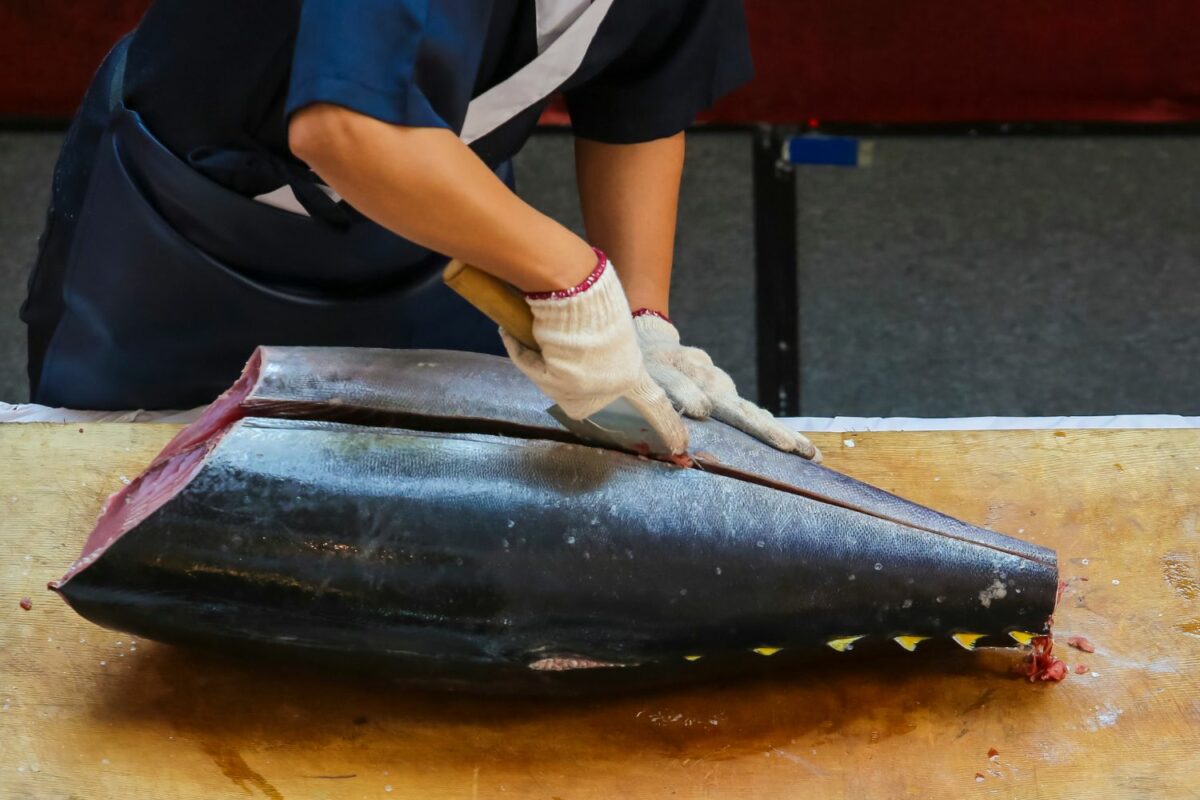
Quiet bidding process
As mentioned, the auction is not the liveliest. It’s mellow and goes on like that until the bidding is finished. The entire process involves a group of restaurant owners and several other buyers walking around and observing the fish quality before they place a bid.
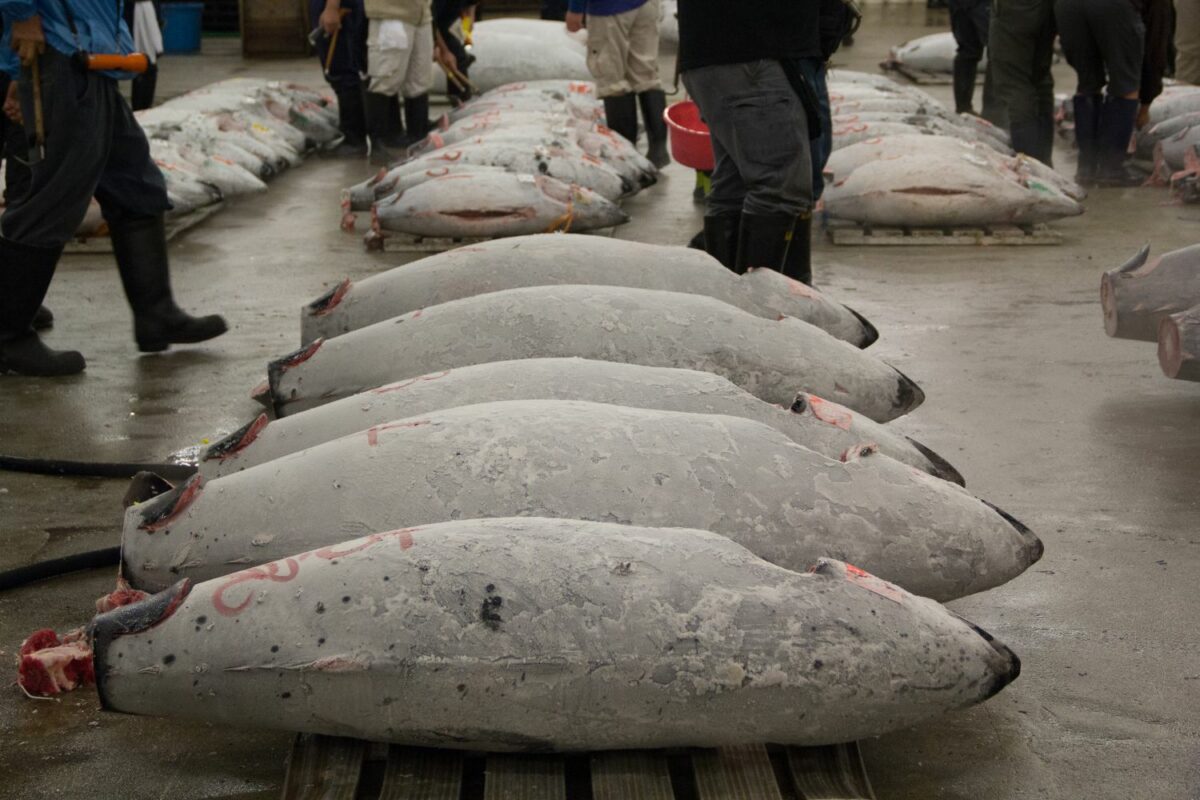
Bids are collected in a wooden box, checked, and the winner gets announced. From here, the fish is packaged in labeled styrofoam containers and tossed with ice to retain its freshness.
Tuna sampling
After the auction, you’ll find a variety of seafood dish options at the market stalls. They offer sashimi, sushi, and more.
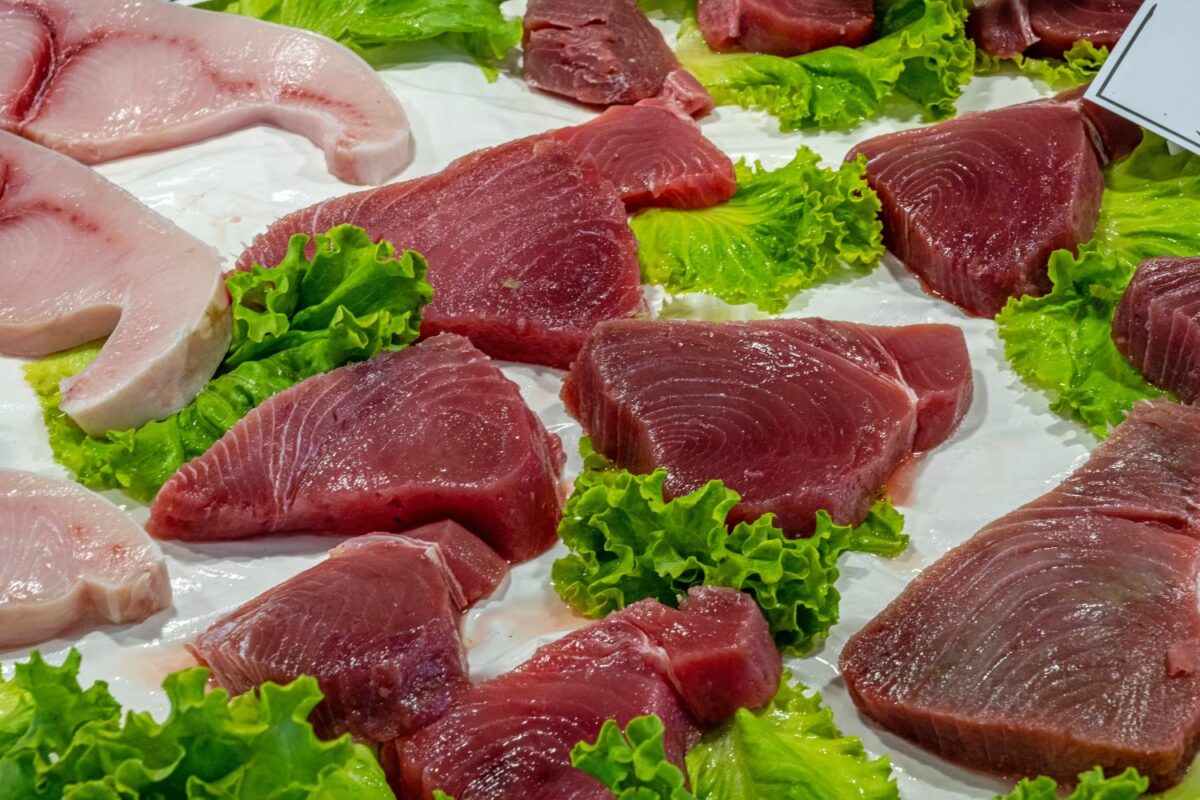
Japan Travel Planning Cheatsheet 🇹🇿
🚑 Should I buy travel insurance for Japan?
100% YES! — Japan has “free” healthcare but it’s only for citizens! Tourists need travel insurance in case anything happens on your visit. Also be aware many policies won’t cover hiking as it’s a high risk activity! (that’s right, check the t&c’s on your complimentary credit card insurance)
I highly recommend World Nomads as you can get specific add-ons for the crazy activities you’re doing – and starts at just $7 a day!
🏩 What’s the best way to book my Kumano Kodo accommodation?
Your only realy two options here are Kumano Travel and Booking.com. Its a complicated process so I wrote this guide here on the best kumano kodo accomodation options
If you don’t want to figure it all out (it’s meant to be a holiday after all) you can book a package tour. Here are my recommendations for both guided and self-guided.
💸How do you pay for things in Japan?
Japan may have flying robots.. but they also still use cash! So you’ll want to get some folding tender out from an ATM when you land. EFTPOS / Debit / Credit Card and Paywave (contactless payments) is common at bigger businesses but small bars, and street vendors want cash.
I personally use a Wise debit card for all my international money needs as they only convert the funds when you make payment, plus they offer a much better spread (margin on the true exhange rate) than the banks do. They work in all Japanese ATMs I tried.
🚙 Do you need to rent a car in Japan?
I wouldn’t reccommend it — Transport in Japan is expensive whatever mode you chose, but fortunalty the publc transport system is out of this world in terms of both freqency and coverage. If you are heading to a lot of off the beaten track places, then you may want a rental. I use Discover Cars to find the cheapest rates on rentals cars and remember you can save money if you avoid picking up at the airport.
🚆 What about the JR Rail Pass?
We didn’t – but it depends on the length and itenirary of your trip. The JR Pass is expensive (and just went up in price again!) and if you’re walking the Kumano Kodo you wont need it for probably 6 days straight anyway.
Do the math, but in most cases buying the train fares you need, when you need it will work out more afforably overall – and give you more flexibility (as the JR Pass doesn’t cover all lines)
📲 How do I get internet/data/wifi in Japan and on the trail?
This one needs a whole nother article, but the short version is;
- local SIM cards are cheaper but generally require a fixed term contract (not practical for people visiting)
- Tourist ‘short stay’ SIMs are a bit more expensive but will give you plenty of data while your visiting and are best for solo travelllers.
- If you’re travelling as 2 or more people, renting a pocket WIFI unit from the airport is the most economical option – Works out cheaper than getting two tourists sims
- Use a travel eSIM like Saily or Airalo. This works from the moment you land is is SOOOOO much easier than trying to pick a data pack in japanese. It also gives you connectivity across neighbouring asian countries if you buy a regional sim! TIP: I used to use Airalo but now find Saily a much better product – you can get 5% off with code SPECIAL5
✈️ What’s the best site to buy flights to Japan?
For finding cheap flights, I recommend Skyscanner. Once you find the flight you’re looking for, I’d then suggest booking directly with the carrier (even if it costs a few $$ more than with one of the agreggators/agencies).
💧Can you drink the water on the Kumano Kodo?
Yes — Japan is very clean. In all townships you’ll pass through and stay along the Kumano Kodo the tap water is drinkable. If you want to drink water from the rivers and streams you generally can but should do so at your own risk. ALWAYS follow best practice and drink from fast flowing water as far up stream as possible. I drank the water and was fine.. but i’d generally recommend a Brita Water Bottle for rehydrating on the trail safely.
🎫 Do I need a visa for Japan?
Likely Not — Japan now recognises 70 countries as ‘visa exempt’ for short term stay. So if you’re a US, UK, NZ, AU and EU passport holder you don’t need a Japansese visas. However, some other countries do (check here!). And if you plan to stay for more than 90 days (an average tourist visa length), you will need to look into the Japanese working holiday visa scheme, or the new Digital Nomad visa scheme.

